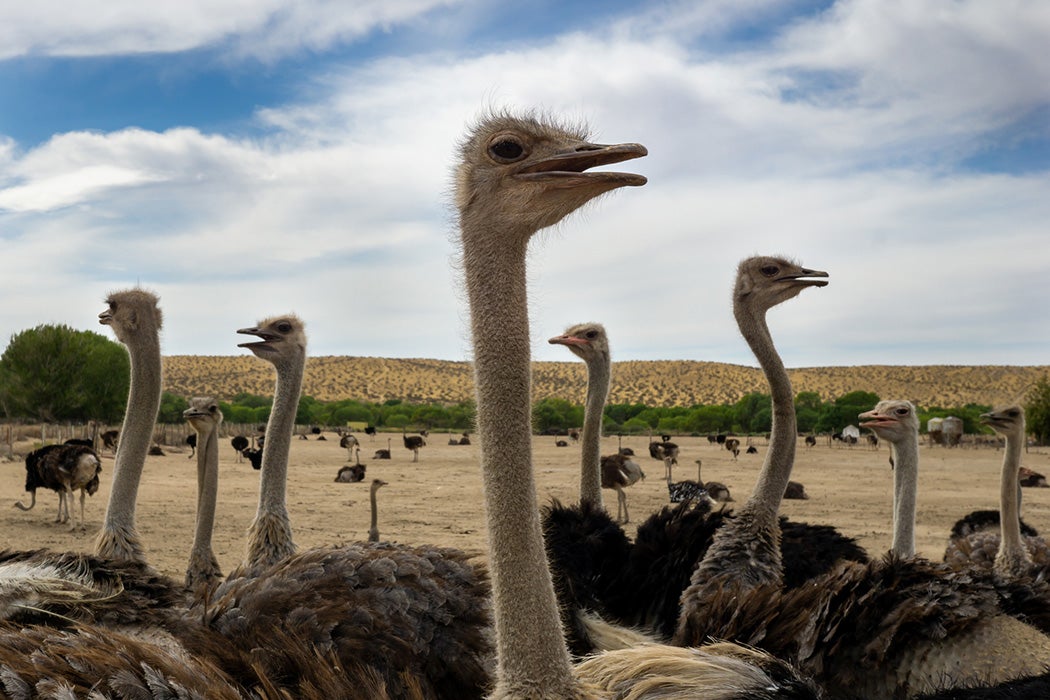Over the past century, farmers and ranchers in the United States have witnessed numerous changes to the livestock scene—tastes change over time, sometimes for health reasons, sometimes for fashion reasons (who doesn’t want a cute pygmy goat around the place?). One farmyard fad that has experienced waves of popularity over the years is the raising of ostriches, a practice which recurs in American history as an agricultural bubble. Ostriches are native to Africa, but campaigns to farm them elsewhere—in the United States, Australia, and Europe—have recurred, despite little-to-no long-term success.
In 1893, Scientific American published a piece by H. C. Hovey on the development of the American ostrich industry over the preceding decades. Hovey was gung-ho on the prospects of the growing industry of ostrich farming. Most recently, he explained, the birds had been imported from South Africa, arriving in New Orleans and Galveston in individual padded boxes, after which they were transported to Arizona and California. The main product at that time wasn’t the birds; it was their plumes, then in high demand for ladies’ hat decorations. (Their eggs were a secondary item; Hovey didn’t mention hides or meat.)
Hovey explained that “plumes are less costly than formerly, yet the business is sufficiently remunerative to attract the attention of enterprising Americans,” concluding “the fact seems to be established that American ostrich farming is an assured success.” (This is the undertone of messaging in such bubbles; those who are “enterprising” or sharp enough will get in on this product, which is the coming thing.)
Yet by the time geographer Robin Doughty was writing in the 1970s, ostriches could be analyzed as a historical failure, although perhaps with some beneficial influence.
Ostrich farming “had important consequences for bird protection in this country and abroad,” Doughty writes.
People sympathetic toward the fad for ornamental plumage at the turn of the century believed ostrich rearing was an answer to what they considered to be “sickly sentimental” attacks on a reputable, longstanding fancy-feather industry. This bird was a unique example of a creature, hard-hunted throughout its range, being rehabilitated and possibly saved from extinction by commercial attempts to raise it in captivity. Millinery agents regarded the commercial rearing of ostriches as an important example of preserving populations of birds of fine plumage from decimation by unregulated hunting.
Farmed ostriches could save other birds from extinction thanks to the feather market. But the ostrich bubble burst when women stopped wearing such fancy hats.
“In 1913 the South African ostrich industry reached its zenith with more than 775,000 birds producing one million pounds weight of plumage for export,” Doughty writes. “By 1920 the figure had plummeted to barely one-quarter that amount in the great crash the industry suffered during World War I.”
Weekly Newsletter
The ostrich story was soon to take another turn, however. A century after the first boom in California, the big birds were back, with an ostrich craze revival in the US in the late 1980s to the mid-1990s. This time the promised commodity was hides (for leather goods) and meat. Once again, those ostriches didn’t lay many golden eggs for their investors.
“The demand for ostrich products had not kept pace with the industry’s supply,” note agricultural economists Jeffrey M. Gillespie and Alvin R. Schupp. The public wasn’t racing to buy ostrich burgers (or ostrich belts), and prices for three-month-old ostriches cratered from a peak of $4,000 in 1993 to $50 in 1998.
Hold onto your (feathered) hats, though: if history is any indication, ostriches are likely to come around again.







